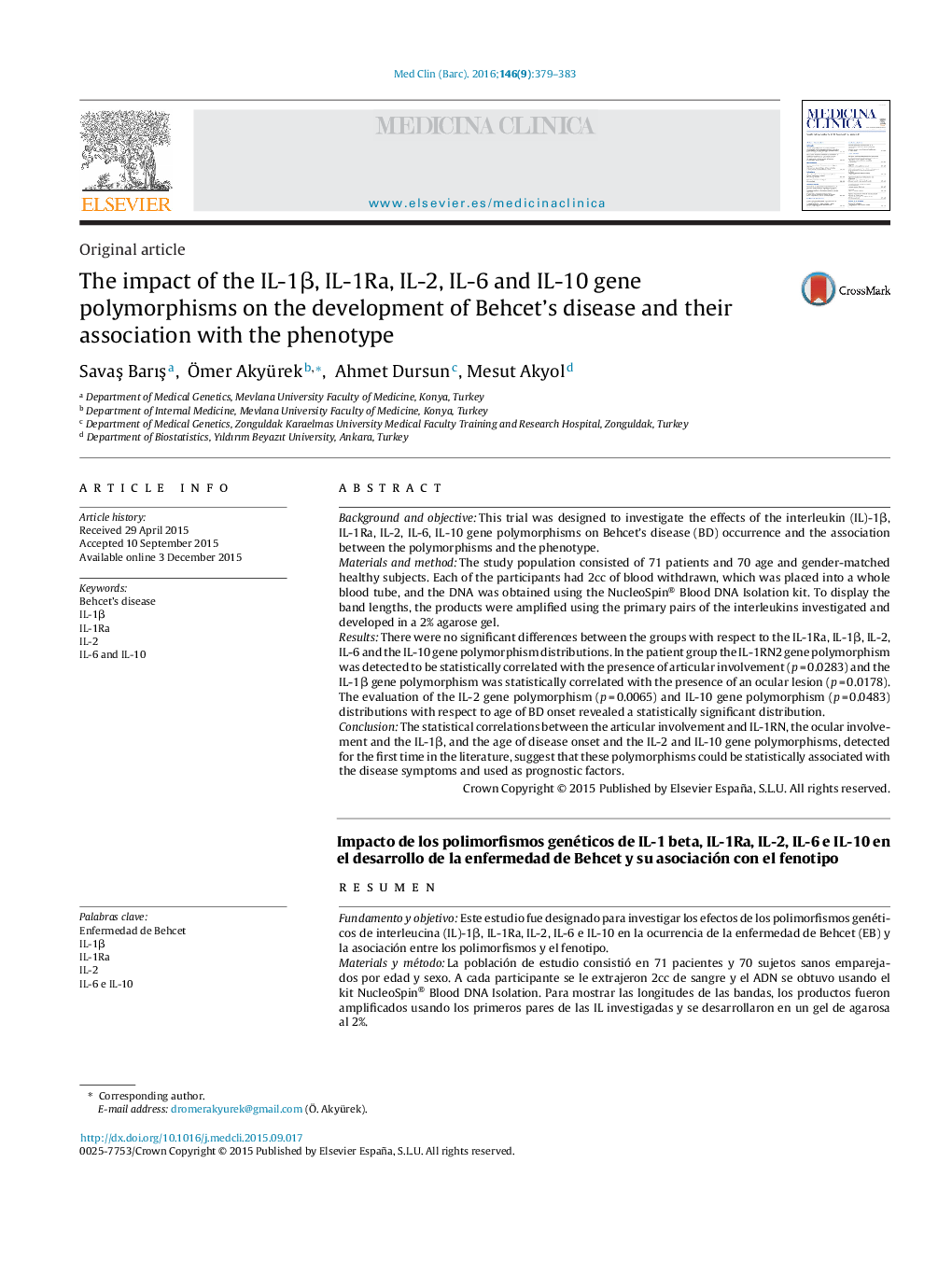| کد مقاله | کد نشریه | سال انتشار | مقاله انگلیسی | نسخه تمام متن |
|---|---|---|---|---|
| 3797951 | 1244328 | 2016 | 5 صفحه PDF | دانلود رایگان |

Background and objectiveThis trial was designed to investigate the effects of the interleukin (IL)-1β, IL-1Ra, IL-2, IL-6, IL-10 gene polymorphisms on Behcet's disease (BD) occurrence and the association between the polymorphisms and the phenotype.Materials and methodThe study population consisted of 71 patients and 70 age and gender-matched healthy subjects. Each of the participants had 2cc of blood withdrawn, which was placed into a whole blood tube, and the DNA was obtained using the NucleoSpin® Blood DNA Isolation kit. To display the band lengths, the products were amplified using the primary pairs of the interleukins investigated and developed in a 2% agarose gel.ResultsThere were no significant differences between the groups with respect to the IL-1Ra, IL-1β, IL-2, IL-6 and the IL-10 gene polymorphism distributions. In the patient group the IL-1RN2 gene polymorphism was detected to be statistically correlated with the presence of articular involvement (p = 0.0283) and the IL-1β gene polymorphism was statistically correlated with the presence of an ocular lesion (p = 0.0178). The evaluation of the IL-2 gene polymorphism (p = 0.0065) and IL-10 gene polymorphism (p = 0.0483) distributions with respect to age of BD onset revealed a statistically significant distribution.ConclusionThe statistical correlations between the articular involvement and IL-1RN, the ocular involvement and the IL-1β, and the age of disease onset and the IL-2 and IL-10 gene polymorphisms, detected for the first time in the literature, suggest that these polymorphisms could be statistically associated with the disease symptoms and used as prognostic factors.
ResumenFundamento y objetivoEste estudio fue designado para investigar los efectos de los polimorfismos genéticos de interleucina (IL)-1β, IL-1Ra, IL-2, IL-6 e IL-10 en la ocurrencia de la enfermedad de Behcet (EB) y la asociación entre los polimorfismos y el fenotipo.Materials y métodoLa población de estudio consistió en 71 pacientes y 70 sujetos sanos emparejados por edad y sexo. A cada participante se le extrajeron 2cc de sangre y el ADN se obtuvo usando el kit NucleoSpin® Blood DNA Isolation. Para mostrar las longitudes de las bandas, los productos fueron amplificados usando los primeros pares de las IL investigadas y se desarrollaron en un gel de agarosa al 2%.ResultadosNo hubo diferencias significativas entre los grupos en relación con las distribuciones de los polimorfismos genéticos de IL-1Ra, IL-1β, IL-2, IL-6 e IL-10. En el grupo de pacientes, el polimorfismo genético de IL-1RN2 detectado se correlacionó estadísticamente con la presencia de afección articular (p = 0,0283), y el polimorfismo genético de IL-1β se correlacionó estadísticamente con la presencia de lesión ocular (p = 0,0178). La evaluación de la distribución del polimorfismo genético de IL-2 (p = 0,0065) e IL-10 (p = 0,0483) en relación con la edad de inicio de la EB reveló una distribución estadísticamente significativa.ConclusiónLa correlación estadística entre afección articular e IL-1RN, afección ocular e IL-1β, y la edad de inicio de la enfermedad y los polimorfismos genéticos de IL-2 e IL-10, detectados por primera vez en la literatura médica, evidencian que estos polimorfismos se asociaron estadísticamente a los síntomas de la enfermedad y se podrían usar como factores pronósticos.
Journal: Medicina Clínica - Volume 146, Issue 9, 6 May 2016, Pages 379–383